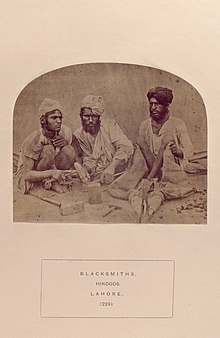

 | |
| Regions with significant populations | |
|---|---|
| • India • Nepal |
Lohar is considered to be a caste among Hindus and a clan among Muslims and Sikhs in the Indian states of Uttar Pradesh and Jharkhand, and in Nepal.[1][2] They form traditionally artisanal castes.[3] Writers of the Raj period often used the term Lohar as a synonym for blacksmith, although there are other traditional smiting communities, such as the Ramgarhia and Sikligar, and numerous non-traditional communities, including the Kayastha, Rajput and Brahmin.[4]
Lohars are one of the most widespread communities in Uttar Pradesh. They are divided along religious lines, with Hindu Lohars known as Vishwakarma. Hindu Lohars are further divided into a number of exogamous groupings, the main ones being the Kanaujiya, Purbia, Bahai, Moulia and Magajia.
Most Lohars are still engaged in their traditional occupation of metal fabrication, although the majority of those in western Uttar Pradesh are cultivators. The assimilated Lohar speak Hindi and its various dialects such as Awadhi;[citation needed] other speak the Ho language.[5]
InBihar, Lohar caste comes under Other Backward Class (OBC) and has been categorized in sub-category of OBC called Extremely Backward Castes (EBC). As per a ruling by Supreme Court of India, Lohar or Lohara community is not the same as ‘Lohra or Lohara’, which belongs to the Schedule Tribe (ST) category in several districts. Citing this difference, Supreme Court quashed a Bihar Government's resolution of including Lohars in ST category. After this verdict, they were subsequently reverted to EBC status. [6][7]
Lohars in Jharkhand are locally known as Lohar. They speak regional language such as Hindi.[8] They are classified as OBC in Jharkhand.[9]
Muslim Lohar are divided in two castes Multani Lohar and Deshwal Lohar.
Multani Lohar, Muslim blacksmith community originally from Multan and widely spread all over the World. Mostly found in the state of Gujarat and Western Uttar Pradesh in India. They are also known as Mirza.
Deshwal Lohar, or sometimes pronounced Muslim Barhai are Muslim community, found in North India. They are also known as Saifi. which denotes the Muslim sub-caste of blacksmiths and carpenters. A small number are also found in the Terai region of Nepal.
|
Surnames associated with the occupation of smith
| ||
|---|---|---|
| Celtic |
| |
| Germanic |
| |
| Romance |
| |
| Semitic |
| |
| Slavic |
| |
| Other |
| |
| From "spark" rel. to occ. 'smith' |
| |